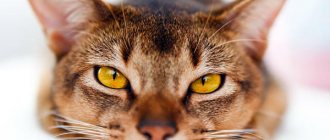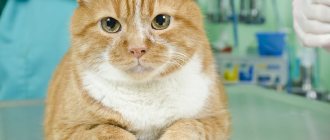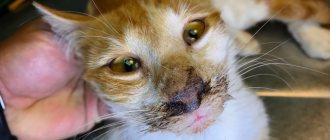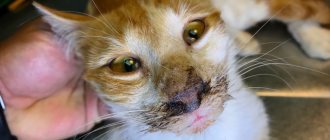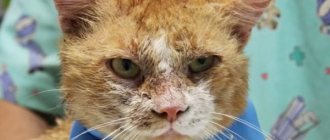Not every breeder of furry pets knows that distemper occurs in cats. This common viral disease occurs not only among dogs, as many of us are accustomed to believe. In most cases, feline panleukopenia (this is the official name for this disease) ends tragically for the pet.
What is feline panleukopenia?
“Chumka” is a popular name. This is the name given to various infections that are characteristic of different types of animals, but have common features - they are very contagious, sick cats often die or have a difficult recovery. In addition, cat distemper is sometimes similar in its course to canine distemper, to which dogs are susceptible. Until 1928, it was even believed that these were the same disease, but their pathogens were different, and cats did not get canine distemper, and vice versa.
The causative agent of the disease is the Panleukopenia feline virus , which belongs to the parvovirus family. Veterinarians and virologists call feline distemper panleukopenia, or infectious gastroenteritis.
The first scientific name describes a characteristic symptom of the disease - a significant decrease in the number of all types of leukocytes in the animal’s blood. The second is a set of symptoms noticeable to the owner: this is an upset stomach and intestines, moreover, caused by an infection, that is, contagious.
It would seem, how is the decrease in the number (up to complete absence!) of leukocytes in the blood connected with inflammation of the gastrointestinal tract? The fact is that the causative agent of panleukopenia needs cells that divide as quickly as possible to reproduce. And these are bone marrow cells, especially those that produce leukocytes (at first the virus causes accelerated production), epithelial cells of the stomach and intestines, fetuses and newborn kittens. But since division is a process characteristic of cells of any tissue of a living organism, the disease actually affects all organs.
How is distemper transmitted in cats?
The incubation period of distemper in cats - the time when the animal has already become infected, but does not yet show signs of the disease - ranges from 2 days to 2 weeks.
The virus is stable in the external environment: at a temperature of 60 degrees it takes an hour to destroy it, and in addition, it is not afraid of standard disinfectants. Alkalies and modern disinfectants that affect viruses help cope with infection indoors.
The virus can exist in the feces of sick animals and virus carriers and retain the ability to infect for up to a year. Given the peculiarities of the course of the infection, the feces of sick animals may end up in the most unexpected places.
Note! Panleukopenia is transmitted only between members of the cat family (all, including wild ones). People and other pets do not get sick from this, but they can transmit the virus through accidental contact with infected secretions - feces, nasal mucus, and so on.
There are the following ways of contracting panleukopenia:
- oral – when any secretions of sick animals enter the cat’s oral cavity;
- intrauterine infection - from a sick mother to the fetuses, which most often leads to the intrauterine death of kittens or the birth of non-viable animals;
- transmissible infection through flea bites and ticks.
The most common route of transmission is the first, which is also the most diverse. Infection occurs through direct contact of animals, through care items, shoes or clothing of owners, hair from dogs that have access to the street, and so on. Any object that could come into contact with the feces of a sick cat or a virus carrier is potentially dangerous.
Effect of the virus
Once in a favorable environment - the cat's body, the virus immediately acts, affecting most of the organs of the already sick whisker. It affects the bone marrow, respiratory organs, intestinal mucosa, heart and lymphoid tissues. Every day the patient’s well-being worsens, because the disease occurs along with intoxication of the body.
Subsequently, heart failure, problems with the digestive tract and dehydration manifest themselves.
If the virus begins to destroy the kitten’s body, then most likely it will not be able to survive. For adults, there is a good chance of recovery, it all depends on the form of the disease and treatment.
An animal that cannot cope with a severe illness dies from heart problems, severe dehydration or another disease.
According to statistics, most often the disease occurs in mustaches aged 6-7 years and furry babies under one year old. In the first case, the immune defense of the tailed creature becomes weaker, and in the second, it has not yet formed.
Symptoms of plague
Panleukopenia has a number of symptoms, which in most cases can be used to suspect the disease.
- lethargy (significant decrease in activity) of the animal;
- refusal of food and water, while there is no interest in food, but there is interest in water;
- an increase in temperature to 40-41 degrees in the first days of the disease and a decrease below 37 degrees subsequently if the course is unfavorable;
- vomiting and diarrhea with a specific, extremely unpleasant specific odor;
- the color of the vomit is first yellow, yellow-brown, then mucous, possibly mixed with blood;
- the stool is liquid, at first yellow-brown, mushy, then lighter, up to transparent mucous;
- abdominal pain, which manifests itself in positions unusual for cats - lying on the stomach with outstretched limbs, sitting, hunched over;
- cats often sit near a bowl of water, but do not drink;
- during periods of high temperature, animals look for cool places, and when it recedes, they look for warm ones;
- upon palpation, the intestinal loops are swollen, inflamed, inactive, and vomiting often occurs after palpation;
- sounds of rumbling and splashing come from the stomach;
- the coat is tousled, dull, the skin loses its elasticity.
The most important laboratory symptom is a change in the leukocyte formula. Neutrophils, which multiply most quickly during the inflammatory process in the body, can drop to zero, but more often it remains within 3...4 × 109. In the early stages, only very old cells can be detected. There are relatively few eosinophils and basophils in the blood, and they too may disappear.
The number of red blood cells may also decrease, but this is not always noticeable, since the hematocrit (the ratio of blood cells to its plasma) increases due to severe dehydration, despite the fact that there are fewer and fewer blood cells. Lymphocytes most often remain normal or slightly increased, and sometimes these are the only leukocytes that can be detected.
Many of these symptoms also appear in other diseases. However, all together they give a fairly typical clinical picture, characteristic specifically of acute panleukopenia. Unfortunately, this disease has a number of other forms.
The pneumonic form of feline distemper occurs with damage to the eyes, mucous membranes of the nasal and oral cavities, bronchi and lungs. In this case, there may be no symptoms indicating damage to the gastrointestinal tract, but everything else remains, and purulent discharge from the nose and eyes, redness of the mucous membranes of the mouth and nose, cough, shortness of breath, and heart rhythm disturbances are added.
The hyperacute, or fulminant form is a sudden severe illness that turns into agony and death within 1-2 hours or less. It is extremely dangerous because the disease can rarely be recognized in a timely manner, which means that other cats are also in danger.
Subacute form - the symptoms are smoothed out, the disease usually lasts 3-4 days and ends with recovery without treatment. This course is typical for animals that have been repeatedly vaccinated against panleukopenia. An important feature of this course is that animals that have recovered from the disease remain virus carriers for a long time and are dangerous for other cats.
Hidden form - the animal is practically healthy in appearance, but there may be a slight decrease in activity, appetite, and mild stomach and intestinal upsets. In this case, the cat releases the virus into the external environment. It's only dangerous to other cats. Many veterinarians believe that this is a latent form - not a disease as such, but one of the types of carriage of the virus.
Diagnosis of feline distemper
In diagnosing panleukopenia, it is important to know whether the animal has been vaccinated, and if so, for how long ago. It is also useful for the veterinarian to know about your animal’s contacts with other cats.
Panleukopenia must be distinguished from diseases of the gastrointestinal tract that arise for other reasons, as well as from poisoning, intestinal foreign bodies and other equally serious diseases. To do this, it is necessary to conduct the following research.
Analysis for panleukopenia: this can be PCR (prepared in 2-3 days), ELISA (can be ready in a day) or a rapid test for this disease (the result will be immediately, but these tests have lower reliability than classical laboratory research methods) .
A general clinical blood test will show whether the cat’s leukocytes are high or low, that is, we are talking about serious inflammation or probable panleukopenia, and will also help determine the severity of the virus damage to the body.
A biochemical blood test is included in the standard of the initial examination of the patient and is necessary if the cause of the pet’s condition is not panleukopenia. If the rapid test for feline distemper is positive, it makes no sense, but if you have to wait for the results of virological studies, it is better to carry out this analysis. If distemper is confirmed, biochemistry will be useful later to assess the consequences of the disease on the pet’s body.
Ultrasound of the abdominal cavity can help to suspect infectious gastroenteritis before the results of virological tests and prescribe the correct treatment; with confirmed panleukopenia in the acute period, it has a low diagnostic value, but after recovery it is advisable to conduct this study.
Treatment of feline distemper
Treatment of panleukopenia is difficult; as a rule, it is intensive therapy, and only in mild cases can you get by with supportive care. The optimal situation for the animal is placement in an infectious diseases hospital, but veterinary clinics provide such services infrequently, and they are expensive.
The primary task of a veterinarian in the treatment of panleukopenia is to maintain the vital functions of the animal’s body. The body can overcome the virus itself, but it does not always have enough time: animals are killed by intoxication, dehydration, salt imbalance, pulmonary and cerebral edema.
The main task at the first stage of treatment of panleukopenia is to eliminate dehydration and replenish the deficiency of electrolytes - minerals that are necessary for the proper functioning of the nervous and cardiovascular systems.
For this purpose, infusion therapy - droppers with saline solutions and glucose. The procedures are carried out in the acute period strictly intravenously, under the supervision of a veterinarian. The infusion rate must be adjusted depending on the patient's condition, otherwise a dangerous complication may occur - pulmonary edema.
Dehydration in panleukopenia occurs for two reasons. This is vomiting and diarrhea, with which the cat loses a lot of fluid, and poisoning with toxins produced by the body itself when faced with the virus. Therefore, the task of infusions is not only to replenish the deficiency of fluid and microelements, but also to facilitate the removal of substances that poison the cat. To enhance this process, diuretics are used.
In addition, it is necessary to protect the animal’s body, which is vulnerable after a virus attack, from bacterial infections. For this purpose, broad-spectrum antibiotics are prescribed as early as possible. They will not destroy the virus, but if microbes join it, the situation will become much more complicated, so antibiotics are necessary.
In Russia, special serums are used to combat feline distemper. The domestically produced immunoglobulin “Immunovet 1 In” showed a good clinical effect. However, the serum works better the earlier it is administered.
Symptomatic therapy is also used to support the animal’s cardiovascular, respiratory, and nervous systems. Vitamin therapy is carried out because the sick body is not able to obtain the necessary substances from food.
Severe anemia (low number of red blood cells in the blood) may require a blood transfusion. This is a rather complex procedure that is not performed in all clinics. Blood for transfusion is purchased from a blood bank or suitable donors are sought, and compatibility testing is carried out before the procedure.
Diagnostic methods
If a relatively young cat comes to the veterinarian with diarrhea, vomiting and low body temperature, he will immediately begin to suspect that she has panleukopenia. If a blood test reveals a reduced level of white blood cells, and there is no vaccination history, the initial diagnosis can be considered confirmed. But not everything is so simple, unfortunately.
Various poisons, feline leukemia, salmonellosis and some other causes can cause a similar clinical picture, but with all these pathologies a sharp decrease in the level of leukocytes is extremely rare. Panleukopenia fully lives up to its name - by the end of the first week from the moment clinical signs appear, it can be very difficult to find leukocytes in the blood smears of a sick animal. The lower their level, the more doubtful recovery becomes. The worst thing is for neutrophils - in severe cases of the disease they cannot be found at all. On the contrary, if the number of leukocytes increases in a blood test, this clearly indicates the beginning of recovery. Finally, in case of poisoning, it is quite simple to understand the mistake - if the medicine (antidote) does not help at all, then the problem is probably not toxins.
Unfortunately, sometimes the diagnosis is made only with the sudden death of young animals. In them, panleukopenia sometimes occurs in a fulminant form. Since there is no one to take a blood test in such cases, they resort to sampling followed by polymerase chain reaction (PCR). However, sometimes this reaction is used to clarify the diagnosis in unclear and doubtful cases. The advantages of PCR include its high accuracy and relatively high speed of data acquisition. There is only one drawback - high cost. If appropriate technology and capabilities are available, the diagnosis is sometimes made based on stool analysis. If the animal actually has distemper, there will be a lot of viral particles there.
Thus, it can be quite easy to pre-determine distemper in a cat, but an accurate diagnosis is usually fraught with difficulties. They are caused by the fact that not all veterinary clinics have sufficiently advanced equipment. Therefore, many experts are of the opinion that in practice feline panleukopenia is much more common.
Prevention of panleukopenia
There is only one way to prevent your pet from getting feline distemper - regular preventive vaccination. The anti-panleukopenia component is included in all modern cat vaccines.
You should not bring animals from the street into your home if you already have cats and especially if they are not vaccinated. If a new cat appears in the house, you need to keep it in quarantine for 2 weeks - without contact with other pets. If during this time the disease has not manifested itself, then the cat is probably healthy, but it is important to remember that it can be a virus carrier.
Preventive actions
To help cat immunity, a vaccine has been created (Nobivac, Quadricat, Felocel, etc.), which works for twelve months, after which the procedure must be repeated.
For the first time, such a vaccine is given to a tailed baby at the age of two months, then after three weeks a revaccination is necessary.
Adult felines are vaccinated every year and this is the most effective way to protect your four-legged friend from the terrible virus.
Before vaccination, you need to make sure that your pet does not have “roommates” - worms and various external microparasites.
Pregnant pets cannot be vaccinated.
Distemper in cats - veterinarian answers to basic questions
What is distemper in cats?
Feline parvovirus enteritis or panleukopenia is a dangerous viral disease better known as distemper. Distemper in cats occurs as a result of the penetration of a highly contagious pathogen of viral etiology into the body. It primarily affects the animal's digestive tract, characterized by feverish conditions and problems in the respiratory system. At the same time, against the background of activation of the pathogen in the body, general intoxication is recorded.
The panleukopenia virus is a small DNA-containing virus, with a size of up to 25 nm. The pathogen has increased resistance to environmental factors. It can calmly withstand and remain infectious when exposed to a temperature of 60 degrees for 1 hour. It is resistant to digestive enzymes, chloroform and diethyl alcohol.
What are the symptoms of distemper in a cat?
There are several forms of panleukopenia in cats. There are fulminant, acute and chronic forms. Most often, distemper affects small kittens and it is in them that the fulminant form occurs, which is rarely treatable and ends in death. The death of the animal occurs on the third day after the onset of the viral disease.
In the chronic form of panleukopenia, there is a persistent disorder in the intestinal tissues, iron deficiency anemia and extreme depletion of the body. In the absence of timely assistance, the animal also dies from degenerative processes in the body.
Less commonly diagnosed is a latent form of feline distemper, which does not manifest itself with pronounced symptoms.
The main symptoms of acute panleukopenia are:
- increased body temperature;
- the animal's refusal to eat;
- the occurrence of nausea and vomiting (vomit is colored green or yellow, with admixtures of mucus or blood);
- the shade of urine changes - it becomes light orange or rich yellow;
- there is a change in the consistency of stool - liquid diarrhea, with a strong unpleasant odor, contains impurities of blood or fibrin strands;
- visible mucous membranes acquire a bluish tint;
- Inflammatory processes occur in the area of the conjunctiva and nasal passages, characterized by the appearance of copious discharge.
In the absence of timely treatment, the animal dies after a few days. Old cats can die from pulmonary edema caused by pathological changes in the body against the background of panleukopenia.
How long does it take to treat distemper in cats?
Depending on the severity of the pathological process, the duration of treatment will depend. In the case of an acute form of the disease, the course of therapy takes from one week to 14 days.
The basis of the therapeutic course is the suppression of the activity of viral agents and the destruction of secondary microflora. Pathogenic bacteria lead to complications of the disease. Doctors are also developing a treatment regimen to restore the impaired water-electrolyte balance and eliminate dehydration.
The use of etiotropic therapy is of decisive importance in the development of treatment tactics. For these purposes, special substances are used that have a stimulating effect on humoral cellular immunity. Interferons that have proliferative and immunostimulating effects are used.
Is distemper transmitted to other animals?
Panleukopenia is only transmitted from cat to cat. Dogs and other pets are not at risk of contracting this disease. Dogs and minks have another, serologically similar type of virus that causes parvovirus enteritis. This infection is also highly contagious and is fatal in young, unvaccinated puppies.
Is plague transmitted to people?
Distemper in cats cannot be transmitted to humans. If you have a sick animal in your home, you should not worry about the risk of infection. Panleukopenia does not have a clear geographical location and can occur anywhere in the world where there are favorable conditions for the development of a viral agent.
It is noted that panleukopenia is characterized by seasonality. The outbreak of the disease occurs on the first warm days after winter frosts. It is during this period that most fatal cases of distemper are diagnosed in domestic cats.
Where could a cat become infected with distemper?
The main source of infection with panleukopenia is infected animals, as well as cats with latent disease. After an animal has suffered from distemper, it remains a carrier of the infection for a long time. Transmission of the pathogen occurs mainly through direct contact of a healthy, but not vaccinated animal with an infected one. Also, the causative agent of the disease gets into the vomit and feces of a sick animal, from where other cats become infected. Transplacental transmission of the causative agent of feline panleukopenia infection cannot be ruled out. This means that an infected mother can become a source of infection for her unborn kittens. In this regard, it is very important that the cat, before the planned mating, is treated for worms, ectoparasites and vaccinated.
How dangerous is distemper in cats?
Distemper in cats, if left untreated, is fatal. In some cases, if a small kitten is infected, it develops a fulminant form of the disease, which, even with timely treatment, ends in the death of the animal. The hyperacute form leads to serious disruptions in the functioning of the body. So, a sick cat loses its appetite and refuses water. There is severe fearfulness, vomiting with foam, white or yellow. If there are disturbances in the functioning of the digestive tract, diarrhea with impurities of blood and mucus is observed. The skin loses its elasticity, the coat becomes disheveled and dull. The nervous form of plague leads to the appearance of tonic or clonic convulsions, often resulting in death. The animal dies within 1-2 days.
There are several forms of panleukopenia in cats. One of them is pulmonary. In this case, inflammatory processes develop in the area of the upper part of the respiratory tract, then the bronchial tree and pulmonary structures are involved in the process. In the area of the mucous membranes of the nose and eyes, specific films of a purulent nature appear. Often, against the background of a prolonged course of the disease, ulcers and minor hemorrhages form. Reducing the clearance of the nasal passages due to swelling and accumulation of exudate leads to increased breathing and shortness of breath. Tissue structures throughout the body lack oxygen. The cat is breathing frequently and may cough and sneeze.
With panleukopenia, not only the gastrointestinal tract and pulmonary system are affected. The cardiovascular system also undergoes degenerative changes. So, if breathing is impaired, the heart rate changes, tachycardia develops and, as a result, extrasystole. In advanced forms of the disease, which are practically the first signs of death, the heart rhythm becomes weaker, bradycardia progresses, and heart failure occurs.
Does distemper vaccination help cats?
The only truly significant method of preventing a cat from becoming infected with distemper is vaccination. There are many different vaccines on the modern pharmacological market. A veterinarian will help you figure out which vaccine is right for your pet after a detailed clinical examination. Vaccination against panleukopenia makes it easier to survive the disease without complications even if infected.
It is not recommended to vaccinate exhausted and clinically ill animals. It is prohibited to vaccinate cats during the period of bearing kittens and while feeding them. Little ones should receive their first distemper vaccination at the age of 1.5 months. This period is the most dangerous for young animals, as the risks of infection and death are very high.
Animals are re-vaccinated 3 weeks after the first vaccination. Further revaccination is carried out according to the vaccination calendar annually. Before making a vaccine, the animal must be freed from possible helminthiasis or external parasites.
Does a recovered animal have immunity?
Unfortunately, a cat that has recovered from distemper has an immune response, but it is very weak. It is better to carry out routine vaccination. Strengthening the cat's immune system is also of particular importance. To do this, you need to take care of the proper organization of the animal’s diet. An integral part of preventing infection with various viral infections, including panleukopenia, is regularly enriching the diet with vitamin and mineral complexes.
In order to prevent infection of a pet, it is necessary to ensure that the animal does not come into contact with stray relatives or known sick cats. Since the main route of transmission of the virus is through contact, it is necessary to ensure that the cat does not come into contact with outdoor shoes. Don’t forget about scheduled medical examinations of your pet at a veterinary hospital.
Treatment of distemper in cats
There is no single, truly effective drug for the treatment of plague. Therefore, in veterinary medicine, to treat a viral infection caused by parvovirus, complex treatment is used aimed at destroying the pathogen. Further in the course of therapy, important places are occupied by eliminating signs of intoxication of the body, preventing the development of complications in the form of a bacterial infection and increasing the overall resistance of the body to the effects of various environmental factors.
The course of treatment and dosage of drugs is determined by the veterinarian based on the individual characteristics of the patient - his age, state of health and degree of advanced disease. Interferons are used as antiviral therapy, proving their effectiveness in the treatment of viral infections.
Symptomatic therapy allows you to restore the disturbed water-electrolyte balance and relieve intoxication. For this purpose, the animal is injected intravenously with various solutions with salts and minerals. Diuretics allow you to quickly remove toxins from the body resulting from the activity of viruses. Painful sensations in the gastrointestinal tract are eliminated by prescribing antispasmodics.
Broad-spectrum antibiotics can prevent or eliminate the development of pathogenic bacterial microflora. As a rule, the entire course of treatment for uncomplicated panleukopenia takes about 2 weeks.
Traditional methods of treating distemper in cats
Most people try to help the animal on their own, listening to the advice of “experienced” people. A common remedy for distemper in dogs and cats is pouring vodka down the throat. Unfortunately, this not only will not get rid of the virus, but will also greatly harm the animal’s body. As a rule, the dose of alcohol is not calculated based on the animal’s body weight, causing serious intoxication. In addition to the intoxication that a cat’s body faces during distemper, it also needs to process a huge dose of alcohol. All this leads to dangerous violations and often increases the chances of death.
Author and presenter of the column: Veterinarian Igor Viktorovich Sanaev
Due to the large flow of incoming questions, free veterinary consultations are temporarily suspended.
Online diagnostic service for cat diseases >
Forms of the disease
Distemper in cats develops subacutely, acutely or superacutely (with lightning speed). Find out more about these forms of the disease:
- Subacute form – typical for cats with strong immunity. The incubation period can last up to several weeks. Clinical signs of plague in the subacute form are not clearly expressed. Full recovery is possible provided that the animal's immune system is at a high level.
- Acute - in this case the incubation period is 1–2 days. Panleukopenia in this form mainly affects adult animals.
- The fulminant form of the disease is typical for young furry pets. Distemper in a kitten develops rapidly - literally within a few hours after the pathogen enters the body. The hyperacute form of the disease is clinically similar to the symptoms of rabies, while the signs often do not even have time to develop, and the animal dies in a very short time.

